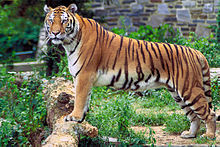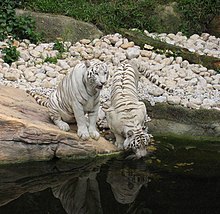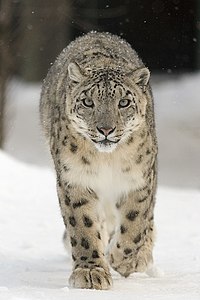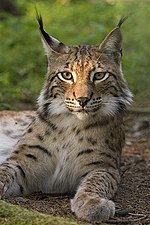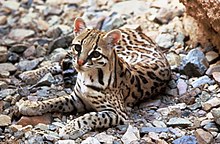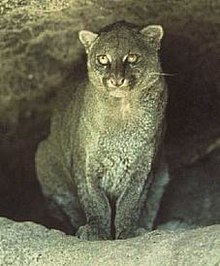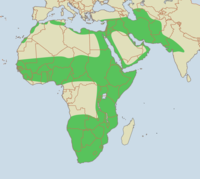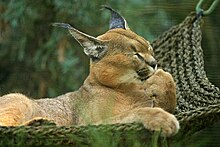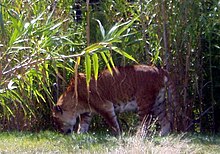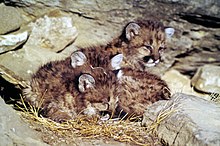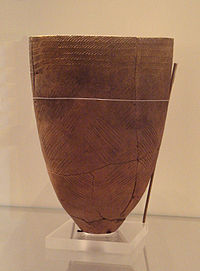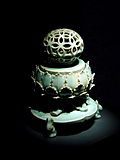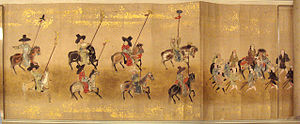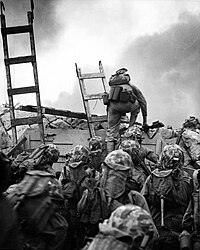[edit] INTRODUCTION
[edit] Foreword
Wikijunior Books welcomes you to the children's book "Wild Cats". Wild cats are some of Earth's grandest treasures, and their stories excite the imagination of kids of all ages. Many of these lords of the wild are endangered, and the children who will one day bear our responsibilities need to admire and love the world so they can enjoy it and pass it on as good or better than they found it. After all, we appreciate what we understand, and save what we appreciate. The importance of this task has led many experts here at Wikibooks to donate their time and talents to bring this volume together.
Wikibooks is a project of the Wikimedia Foundation, aimed at providing free, easily available quality reading for adults and children to promote the global spread of knowledge. Traditional publishing houses make the bulk of their income from re-issues of classic books, new books by authors with long track records, or celebrities who are famous in their own right. The chances of a truly good new work being published solely on the basis of merit skyrocket when you overturn the traditional business model and tap the wellspring of new talent out there using the 'net.
With this project we have reached a crossroad between the books of yesterday, and the encyclopedia of everything for tomorrow. Simply by reading this book and telling your friends, you have advanced the cause of free access to information and of democratizing the field of publishing. Thank you, and once again, welcome.
[edit] Meet The Cats

An African lioness surveys her domain
In Africa, they say that a male lion roars Hii inchi na ya nani? Ni yangu, yangu, yangu! (Whose land is this? It is mine, mine, mine!). It is hard to listen to this ancient challenge without edging a little closer to the campfire. But what is behind that remarkable call? Certainly, to some degree, all cats are cats, everywhere you look. When you see one of the neighborhood tabbies stalking a squirrel, you can see a miniature tiger stalking deer on the meadows of Rhanthambore.
[edit] Superb Predators
Tigers and lions are among nature's grandest predators. A grizzly bear may be larger than a Siberian tiger, but the tiger is much quicker. A wolf may have a better sense of smell than a jaguar, but a jaguar can handle large prey alone while wolves hunt in packs. Cats have excellent night vision, sharp hearing and enormous physical strength. They sneak up on their prey; the camouflage patterns in their fur and their graceful, quiet movements make the cats difficult to notice.
There are cats for every job. Each continent except for Antarctica has its cat king. Africa is ruled by the lion, Asia by the tiger (although the Himalayas too high for tigers has the snow leopard). In South and Central America the monarch is certainly the jaguar. North America is the domain of the puma. Australia has no big cats, but it has many small cats that descend from tame cats but have since gone wild. Like their giant relatives, these cats have become king predators even if they are much the same as the pet cats that you have met.
The natural order is carefully balanced. There are a few big predators. Under them are more medium sized cats that eat medium sized prey ranging from rabbits to antelopes and deer. Finally, there are many small cats (including loose pet cats) that eat the far more numerous small prey like insects, rodents, lizards, and birds. The secret to their success is the concept of the niche, a special job each cat holds that keeps it from competing with others. A shopping mall with nothing but music stores would see a lot of fighting over customers. Like a shopping mall, a natural environment keeps order by having a variety of different plants, prey species, and hunters. The field mice that don't interest the tiger keep the wild cat happy, and the cheetah zooms after a small antelope while leaving the buffalo for the stronger lions.
Cats hunt because they need meat to survive. Animals that eat grass and leaves have special stomachs that allow bacteria time to break down complex plant sugars into the simpler sugars animals can digest. Cats have a very short digestive tract that quickly breaks down meat and absorbs its energy and building materials. Cats cannot survive on a diet of grass, therefore they live from the meat they can get from other plant-eating animals. That is how the food chain works.
[edit] Intelligence
Cats are among the most intelligent species on Earth. They are ranked just behind primates (monkeys and apes), cetaceans (whales and dolphins), elephants, pigs, and seals. Lions use group strategies (much as do wolves, which are not cats) to tackle large and dangerous prey. All cats are very curious and can learn quickly. Large predators need to be extra smart in order to be successful as hunters. Mother cats spend a long time (one to two years) teaching their offspring the many things they need to know in order to survive. You may also consider this time of their life as their school time, where they learn how to deal with the world they live in.
[edit] Found Everywhere But Safe Nowhere
Cats are native to all continents but Australia and Antarctica. In Australia, the only cats are small ones. Unfortunately, many of these wonderful creatures face extinction or are critically endangered. Cats are often hunted for their fur or meat. In Asia, thousands of tigers are killed each year just for their bodyparts. They are also killed by people who want the animals that cats hunt all to themselves. Still, other people hunt cats for sport. Worse, the healthy environment that cats need to survive is not being treated with the respect it deserves.
Fortunately, more and more people now think of cats as companions to be admired rather than enemies to be destroyed. Learn more about these great cats and their remarkable world and share what you learn with your family and friends. After all, when we understand something, we can appreciate its value much better. Valuable things, including the marvelous cats, large and small, are worth protecting. To keep these superb predators in the world our children and grandchildren will live in, we must learn to make room for other living things to use Earth's limited resources.
[edit] GREAT CATS
Lions are a major symbol of wild Africa. They have been worshipped by African tribes for their strength and beauty. Lions are the only big cats that live in large groups. Also, they have the loudest roar of any cat, which can be heard for up to five miles!
[edit] Where do lions live?

Places where lions live are colored green.
Despite the nickname King of the jungle, lions do not live in the jungle. They live in a flat grassy plains called savannas; they usually have a certain place in the savannas where they like to stay. In ancient times, lions roamed nearly every continent. Today, they can commonly be found across central and southern Africa. There is also a small population in the Gir forest of India on the continent of Asia.
[edit] What do lions look like?
Lions have tawny, or yellowish brown, fur. They grow to a length of about 10 feet (3 m) and stand about 4 feet (1.2 m) tall. Male lions are larger than the lionesses (females), weighing as much as five men or about 550 lb (250 kg). The more slender lioness usually weighs about as much as two and a half men or 400 lb (180 kg).
Adult males can be recognized by the furry mane that runs around the heads and down the neck. For some lions the mane even runs along the belly. There is no other big cat with such a dramatic difference in appearance between males and females.
Both lions and lionesses have tufts on the end of their tails, something no other cat has. If you could touch a male lion's tail, you would feel a sharp bone tucked into the tail tuft. One old legend claims that lions would use the tail spur to whip themselves into a frenzy before fighting.
[edit] What is a pride?
Lions are the most social cats, living in large groups called prides. Prides are made up of one to three related adult males, along with as many as thirty females and cubs. The females are usually closely related to each other, being a large family of sisters and daughters. Lion prides act much like packs of wolves or dogs, animals surprisingly similar to lions (but not other big cats) in behavior, and also very deadly to their prey.
The male lion is much stronger than the female. This makes him an able protector, especially when a group of females are hunting and the cubs are at risk of marauders, such as hyenas. Male lions use their muscles and fighting skills to guard the land and keep enemies away. Sometimes those enemies are other lions.
In prides, cubs are cared for not just by their mothers but by other adult females, as well. Often, one or two lionesses (female lions) will stay with the cubs while the other females hunt. If a cub becomes an orphan, it is common for it to be cared for by other females who are related to it, perhaps by a lioness who is an aunt or older sister.
According to a study on sciencedirect.com, "male lions were frequent and successful hunters. The main prey species of all male group types, but particularly nonterritorial males, was buffalo. By contrast, females preyed more frequently on the most abundant medium-sized ungulates, such as wildebeest." There are photographs of both male and female lions hunting at http://www.laocomics.com/blog/category/animals/.
When young male lions reach the age of one year, they are chased from the prides they are born into by the older male lions. If the lead male is elderly, the young male, either alone or with male siblings, will sometimes fight to take over the leadership of the pride. If the young males leave the pride, they become "rogue" males. They travel alone or may partner with other rogues, perhaps brothers. Having a partner makes it easier for a rogue lion to survive and eventually win a pride of his own. These rogue lions are often found scavenging food killed by smaller predators, such as hyenas or jackals, which can be chased away. Rogue lions hunt for themselves until they are able to take over a pride of their own!
[edit] What do lions eat, and how do they catch their prey?

A lioness tries to move a buffalo
Lions eat large prey, such as gazelles, antelopes, zebras, wildebeests, giraffes, and buffalo. They have been known to take down even elephants, but then only with all of the adults of the pride participating in the kill. Even elephants dread lions. When food becomes scarce, lions will hunt smaller prey or sometimes eat the kills of other animals.
Most prey animals can run much faster than the average lion. Therefore, lions hunt in fairly well organized groups and stalk, or sneak up on, their prey. They may try to surround them first, then make a swift, sudden charge from the tall grass. The grass where lions live is not short and green but grows very tall and is a light brownish color most of the time. The lions' fur is the same color as this grass, making it difficult for other animals to see them. Coloring that helps to hide an animal or thing is called "camouflage".
Females do most of the hunting and work in groups although, if she has to, a single lioness is able to hunt on her own. Male lions are actually more capable hunters than females but they usually focus more on protecting the pride. Lions might spend hours stalking prey but the actual kill is made in just minutes. After a kill is made, the females let out low roars. This tells the pride to join them for a meal. Adult males eat first, followed by females, and then cubs.
To avoid the dangerous heat of the mid-day sun, lions usually hunt at night when the dim light helps to keep them hidden from their prey. Lions have very good night vision so the darkness does not pose a problem for them. Animals that are active at night like lions are called nocturnal creatures. Lions can eat 69kg of meat a day!
[edit] Fun facts

A male lion has a mane of long fur around his face.
- A male lion's roar can be heard up to 5 miles away.
- The hunting grounds for a pride of lions can range from 8 to 150 square miles.
- The largest lion on record was almost 11 feet long and weighed nearly 700 pounds.
- Lions rarely eat an entire kill. Hyenas and vultures finish the rest.
- A lion can run as fast as 35 mph for short distances and can leap a distance of more than 30 feet.
- There are only one fourth the number of lions in Africa as there were just 40 years ago.
- A lion's eyesight is five times better than a human's eyesight, and it can hear prey that is more than a mile away.
- It may take up to 4 hours for a pride of lions to finish eating.
- A male lion eats first, even though the females actually catch the prey.
- After eating, a thirsty lion may drink for as long as 20 minutes.
- Lions were once thought to be magical creatures and were worshiped as gods. Domestic cats replaced lions in that role, especially in Egypt, because they were much safer and easier to care for.
- There can be up to 40 members in a pride with over half of them being cubs and young adults.
- Females will often stay with the pride their entire life, while young males are driven out.
- A lion eats 36 kg of meat a day.
- When a male lion gets old, its mane may fall off.
- The lion is the only social predator among the Big Cats.
[edit] For more information
[edit] Tigers
Their speed and agility give the tiger the title of "Top Predator," over the larger but slower grizzly bear. The tiger is the largest and most powerful cat species living today. A well rounded athlete, the tiger can climb (though not well), swim, leap great distances and pull with five times the force of a strong human. The tiger is in the same group (Genus Panthera) as lions, leopards, and jaguars. These four cats are the only ones who can roar. The tiger's roar is not like the full-voiced roar of a lion, but more like a sentence of snarly, shouted words.
[edit] Where do tigers live?

Places where tigers live are marked in dark green
Tigers live in forests and grasslands of eastern and southeastern Asia. They live in countries such as Bangladesh, Bhutan, China, India, Nepal, Cambodia, Laos, Malaysia, Myanmar, Thailand and Vietnam, Indonesia (Sumatra), and the Russian Far East. The Bengal Tiger is the national animal of India and Bangladesh.
[edit] What do tigers look like?
Like the other Big Cats, tigers are built much like the much smaller domestic cats that people often have as pets; they are just much bigger and more powerful.
Tigers are usually orange or reddish orange with very bold, uneven black stripes and white areas on the chest, neck, belly and inside of the legs. Their stripes act as camouflage, making it difficult for them to be seen when they are among the trees and shrubs of the jungle. The stripes will vary with each individual tiger.
A tiger usually is about 6 ft to 9 ft in length from nose to tail tip. A large tiger might be 10 ft (3 meters) long. The tail is about 36 inches (91 cm or 3 ft). Tigers weigh about 350 to 550 pounds (160 to 250 kg).
Tigers have very strong teeth and jaws. Their paws are soft and heavily padded, sheathing large, very sharp claws. They also have short, thick, and soft fur and thick long whiskers.
White tigers are those who are born with a certain genetic defect causing loss of pigment in their skin, eyes and fur. These tigers can be white with black, grey, very dark blue, or no stripes; they are not albino.
This loss of pigment is unfortunate for tigers in the wild because their camouflage becomes inadequate. However, this trait may be even more unfortunate for tigers held in captivity. White tigers held in captivity are often forced to breed with their mothers, fathers, siblings, etc. This is usually done to assure that another white tiger cub will be born due to the fact that they are rare and draw in large crowds to zoos, circuses and magic shows. Because these unusually colored tigers are so beautiful and rare, the majority of the public is oblivious to the horrible effects that inbreeding causes in tiger cubs.
These effects may include: an elevated incidence of recessive genetic diseases; reduced fertility both in litter size and in sperm viability; increased congenital defects such as cryptorchidism, heart defects, cleft palates, fluctuating asymmetry (such as crooked faces, or uneven eye placement and size); lower birthweight; loss of immune system function; slower growth rate, smaller adult size; mental retardation, and an increased risk of infant mortality.
[edit] What do tigers eat, and how do they catch their prey?

A Siberian tiger chasing a deer
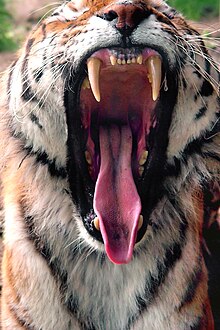
Tigers have very strong jaws
Tigers mostly feed on plant-eaters, or herbivores, like elk, deer, wild pigs, and buffalo. Like the majority of cats, they are solitary hunters, meaning they hunt alone. When a tiger has spotted its prey, it may seek out a good location where it can hide, staying close to the ground, and wait for the perfect moment to pounce and ambush its prey. But when prey becomes scarce tigers also hunt peacocks.
People who traditionally live in areas where tigers hunt have learned to avoid tiger attacks by wearing a face-mask on the backs of their heads. Tigers prefer to approach other animals from behind and think twice about pouncing when they can see a face. Fortunately, they rarely attack humans unless they are too ill to hunt their normal prey. [1]. Tigers that attack humans are called man-eaters. Jim Corbett was a famous hunter and conservationist who killed a lot of man-eating tigers in India.
[edit] Fun facts
- Tigers are striped through and through. If you were to shave a tiger, and few ever have, you would see the stripes on the skin.
- Tigers are superb swimmers, unlike most other cats. They have been known to board fishing boats from the waters in which they swim. Usually they swim because they want to cool off.
- No two tigers have exactly the same pattern of stripes.
- The Siberian tiger is the world's largest naturally occurring cat.
- A tiger was once measured to be 14 feet long.
[edit] For more information
[edit] Leopards
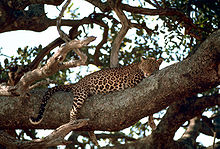
Leopard relaxing in a tree
The leopard is the champion athlete of the cat world. Most big cats can pull with five times as much force as the same weight of human athletes. The leopard can pull seven times as hard. It would take three olympic class weightlifters merely to achieve a draw at tug of war with one 100 pound leopard. This amazing strength is demonstrated when a successful hunter scrambles up the side of a tree with a full grown antelope in its jaws to eat in peace.
The leopard gets its name from the ancient Greek words for "lion" (leon) and "spot" (pard). So originally the name "leopard" meant "spotted lion."
[edit] Where do leopards live?
Leopards live in the Middle East, parts of Asia, and Africa. This means they live in more places than any other big cat. Leopards spend a lot of time in trees, often sleeping draped over a branch. They will even pull entire prey animals up into the branches where they can eat without having to fight off other predators trying to steal their food.
[edit] What do leopards look like?

A baby spotted leopard cub.
Leopards are usually 6.5 to 10 feet (2-3 m) long, including 23-43 inches (58-110cm) of tail, and weigh about the same as a human or a large dog, 65-155 pounds (30-70 kg). They stand 17.5–30.5 inches (43-78 cm) tall. Female leopards are usually only two-thirds the size of male leopards.
A leopard's coat is short and sleek. Depending on where it lives, a leopard's coat can be a pale straw color, grey, ochre, or black. All leopards have black spots. Because the fur in a leopard's spots is thicker and more coarse, they can be felt as well as seen.
Black leopards are sometimes called panthers, and they were once thought to be a separate species. Though they are all black, they still have the black spots that leopards are famous for. On black leopards, these spots are only slightly darker than the surrounding fur, but under very bright light, they stand out from the lighter, somewhat purplish, background fur.
[edit] What do leopards eat, and how do they catch their prey?
Leopards tend to eat antelopes and similarly sized herd animals. They avoid the larger herbivores, such as water buffalo, because the larger beasts can only be safely captured by groups of animals that hunt in teams, such as lions. Leopards also eat smaller animals including rodents, rabbits, and even large insects. Some have been known to eat Nile crocodiles, which are powerful reptiles!
They are known to kill and eat dogs, so those persons who bring a dog into leopard country are advised to cage the dog so that it does not become food for leopards.
[edit] Fun facts
- In captivity, leopards are the most temperamental of the large cats and can be difficult to handle. While they can be affectionate, they cause an unusually large number of animal-related injuries among caretakers in zoos, circuses, and animal care centers.
- It is built like and acts much like a house cat, so anyone fascinated by the big cats might as well have a house cat that behaves much the same as a leopard -- except that a house cat can't hurt you a lot when it scratches or bites.
- One of the funniest movies ever made was one called Bringing Up Baby. It is old -- it was made in 1939 and it is in black-and-white -- and it stars a leopard named "Baby" that creates problems for the great human movie stars Cary Grant and Katherine Hepburn. (If you don't know who Cary Grant and Katherine Hepburn are, then ask an adult over 50. Those were two of the greatest movie stars ever).
But don't ask for a pet leopard. A little house cat is far safer.
[edit] For more information
[edit] Jaguars
The Jaguar is sometimes called Onça by South Americans and El Tigre (the tiger) by Central Americans. Long ago, they called it Yaguara, the "cat that kills with a single spring." Both names convey the awe and reverence this largest New World cat inspires. Their gold coat spangled with black rosettes was said to be the stars of night. In the Mayan religion, the sun took the form of a jaguar when travelling through the underworld at night. Jaguars are closely related to lions, tigers, and leopards. The jaguar and leopard are almost the same but their spots are different. If you look very closely you will see that they have a different pattern.
[edit] Where do jaguars live?

Places where jaguars live are colored green.
Jaguars live in the rain forests and more open countryside in South and Central America, and are the largest members of the cat family there. Jaguars are strong swimmers and climbers, and they often prefer to live by rivers, in swamps, and in dense forest with thick cover for stalking prey.
Jaguars once lived as far north as the southwestern United States. The last wild jaguar in the United States died around 1960. Some of these cats are once again migrating north from Mexico.
[edit] What do jaguars look like?

A black jaguar clearly showing its darker spots
Jaguars look very similar to leopards, but they behave more like tigers. The jaguar has the strongest jaw structure in the cat family. Its powerful cheek muscles and lower jaw gives the Jaguar a much more rounded face than the leopard. Jaguars are also rather short-legged compared to other cats, which increases their strength rather than their speed.
Jaguars usually have background fur that is orange-yellow in color. There are numerous rings of spots on their flanks and spots on their heads and necks. Jaguars and leopards can be distinguished by the fact that jaguars have spots within the centers of their ring markings, while leopards do not. Some scientific evidence suggests these two cats are very closely related but jaguars are native to the New World while leopards are native to the Old World . There are some jaguars that seem to be entirely black in color, but the spots can still be seen if you look closely. Jaguars with the all black coloring are sometimes called black panthers, but they are really jaguars.
[edit] What do jaguars eat, and how do they catch their prey?
Jaguars mostly take large prey, such as deer and peccaries, but they are great opportunists and will eat anything from frogs and mice to birds, fish, and domestic livestock. Jaguars can run quite quickly, but do not have much endurance and rarely make long chases. Their strong, muscular jaws let them crush through large, thick bones and they can even crunch through a turtle's shell quickly. This great strength allows these cats to crush the skull of prey animals rather than suffocating them with a neck bite, as most cats do. Jaguars have very good night vision and do most of their hunting on the ground at night. They are nocturnal creatures, meaning that they prefer to be active at night.
[edit] Fun facts
- Jaguars will sometimes wait by the water, hitting it occasionally with their tail. When fish are attracted by this, they swipe out with a paw, spearing the fish in their claws.
[edit] Snow Leopards

A snow leopard's coat protects it from the cold
Snow Leopards dare to live where icy gales would freeze a human's blood in minutes. Their bodies are adapted to survive and thrive in an icy wilderness of breathtaking beauty and great danger. Until recently, no one had photographed a snow leopard in the wild.The first ever close-up pictures taken by humans were made by program Planet Earth, although very few people have had the privilege of seeing a snow leopard in its native habitat, much less taking its picture. The snow leopards seem to like it that way -- they avoid humans with amazing skill. Their fur contains swirls of gray and black, much like the colors of the rocky outcrops where they live. This coloration provides such good camouflage that a snow leopard can seem to disappear just by staying still.
[edit] Where do snow leopards live?

Places colored green are where snow leopards live
Snow leopards live in the high mountains of China and Central Asia, particularly throughout the Himalayas. They typically have a hunting range or territory of 100 square miles (260 square km), because very few prey animals live in the harsh, mountain habitat that is home to the snow leopard.
[edit] What do snow leopards look like?
Snow leopards have grey-and-white fur with long tails and rosettes on the flanks and spots on the head and neck, like jaguars. This color resembles the rocks and snow of their environment and helps them stalk their prey. Their tails are unusually long, thickly furred, and striped. Their paws are covered in fur to keep them warm and to act like snowshoes. During blizzards, they wrap their tail around their face, using it like a muff, to keep warm. Their eyes are round in shape, ranging from pale green to grey in colour. Male snow leopards weigh between 90-115 pounds (40-52 kg), and females weigh between 75-90 pounds (34-40 kg).
[edit] What do snow leopards eat, and how do they catch their prey?

Snow leopards are masters of vertical space
Snow leopards eat almost anything they can catch, often hunting animals three times their size. Their main sources of food include wild sheep and goats, pikas, hares, and game birds. In the summer, they eat mostly smaller prey, such as marmots. At other times their prey includes wild boars, gazelles, markhor, bobak, tahr, ibex, bharal, mice, and deer. They stalk their prey and usually begin their attack when they are 20 to 50 feet (6-15 m) away.
The snow leopard's broad paws act as snow shoes and give them traction as they chase their prey across stone, snow, and icy surfaces. They are at their best when they can run across the hard, icy crusts that form above banks of deep snow while their hooved prey breaks through the crust, getting mired in the soft, underlying snow.
[edit] Fun facts
- The snow leopard has the longest tail of any cat.
- Snow leopards will attack prey weighing four times as much as themselves.
- The large, thickly furred paws of the snow leopard act as built-in snowshoes.
- Snow Leopards have the thickest fur of all cats
- Unlike most other big cats such as the lion, snow leopards cannot roar.
[edit] For more information
[edit] Clouded Leopards
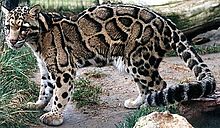
A clouded leopard is at home in trees
Clouded leopards are not truly leopards at all but they spend a great deal of time in trees, just as the true leopards of Africa do.
[edit] Where do clouded leopards live?

Areas where the clouded leopards live are colored green
Clouded leopards live throughout southern China, the eastern Himalayan Mountains, south-east Asia, and some parts of Indonesia. They prefer to live in tropical or subtropical forests, yet they can also be found living in mangrove swamps and grasslands.
The clouded leopard is a medium-sized wild cat found in the forests of Asia. Little is known about the wild behavior of clouded leopards due to their extremely secretive nature. Much of our understanding of this cat’s natural history and behavior is a result of observations of them in captivity.
[edit] What do clouded leopards look like?

A clouded leopard at the San Antonio zoo
At adult age a clouded leopard will range from somewhere between two and a half feet, nose to rump, to three and a half feet. The clouded leopard has short legs for its size. It also has the longest canine teeth (2 inch fangs) for any similarly sized cat species that lives today. Only the extinct sabretooth cats had longer canine teeth for their body size.
Clouded leopards are excellent climbers and their major prey animals live in trees. Short, flexible legs, large paws, and keen claws combine to make them very sure-footed in this environment. The clouded leopard's tail can be as long as its body and helps to maintain the cat's balance while moving through the trees. Amazingly, these cats can hang upside-down under branches, and can even climb down tree trunks head-first. Other cats cannot do this because their claws are not shaped in the same way.
The beautiful pattern of the clouded leopard's fur is its most interesting feature. The large square rosettes look like clouds to some people, and that is how they got the name "clouded leopard." Other people think the blotches look more like mint leaves, so they are also called "mint leopards."
[edit] What do clouded leopards eat, and how do they catch their prey?
While not much is known about their behaviour in the wild, their prey is thought to be mostly mammals that live in trees, particularly monkeys, along with small mammals, deer, birds, porcupines, goats, wild boar, young buffalo, and domestic livestock.
[edit] Fun facts
See how much you know about the clouded leopard:
- They can climb down tree trunks head first.
- Like marbled cats and margays, they will sometimes hang head-down from branches using their hind legs.
- Young clouded leopards are born with spots that become open squares as they grow older.
[edit] For more information
[edit] Marbled Cats
The marbled cat is the big cat that isn't big at all, only slightly larger than a domestic cat. Scientists place it in the same closely related group as the lion, tiger and leopard, the Subfamily Pantherinae, and even though it's much smaller than the clouded leopard it has the same long fangs and a very similar fur pattern. Scientific examination of their blood (blood serum analysis) suggests that they are similar in form to the forest ancestors of the big cats some ten million years ago. However, they may have also decreased in size more recently due to competition with other big cats.
[edit] Where do marbled cats live?

Places where marbled cats live are colored green.
The marbled cat may be found in the forests of the Malay peninsula, Sumatra, Borneo and some neighboring small islands.
[edit] What do marbled cats look like?
Marbled cats look similar to clouded leopards but they are smaller, have shorter faces more like a domestic cat, and have a fuzzier tail. Its beautiful, striking coat is pale brown, with irregular slightly darker brown blotches sharply outlined in dark brown or black. Its long cylindrical tail is full from rump to tip and carries its body pattern.
[edit] What do marbled cats eat, and how do they catch their prey?
Marbled cats spend a great deal of time in the trees and it is likely that they catch much of their prey there, hunting birds, squirrels, rodents, frogs and reptiles. They have been seen hunting on the ground on the island of Borneo, and this may be a local habit. Not much is known about their habits because they are rare in the wild and there are no specimens currently kept in zoos.
[edit] Fun facts
- Marbled cats make sounds similar to a domestic cat, but they purr rarely and their meow is somewhat like a twittering bird call.
- The longest a marbled cat lived in captivity was 12 years.
[edit] For more information
[edit] SWIFT CATS
[edit] Cheetahs
Cheetahs are built for speed, with a whiplike spine, long legs, and a long tail that acts as a rudder for sudden turns. They are the world's fastest land animal, able to sprint up to 70 miles per hour (110 kph) for short distances in pursuit of prey. They can go from 0 miles per hour to 70 miles per hour in just a few seconds. Because they bond well with humans, cheetahs used to be raised in captivity for catching wild game. They are also known as Hunting Leopards.
[edit] Where do cheetahs live?

Places where cheetahs live are colored green.
Today, most cheetahs are found in sub-Saharan Africa, though a few are still seen in Iran. In the past, they used to be found throughout northern India and Iran. They prefer to live in semi-deserts, savannas, prairies, and thick brush. Because they rely upon speed to hunt, they avoid dense forests. Conservation efforts are required in order to avoid the cheetah becoming an entry on the endangered species list.
[edit] What do cheetahs look like?
Cheetahs are medium-sized doglike spotted cats with long legs and lean bodies. They have a white belly and a dark stripe that looks like a tear on both sides of their face. Cheetahs also have round dark spots on their fur. Adult cheetahs weigh from 90 to 140 pounds (40-65 kg), and are around 4 to 5 feet (112-135 cm) long. Cheetahs are built to be the best runners. Their long tail provides them with balance. They have a big chest, a narrow waist, and powerful hind legs. They have a small head and muzzle, large nostrils for increased oxygen intake, and small round ears. All of this makes the cheetah very sleek and aerodynamic when it runs.
[edit] What do they eat, and how do they catch their prey?
Cheetahs mostly eat mammals like gazelles, impala, gnu calves, and hares, which are all about the same size as, or smaller than, an adult cheetah.
Cheetahs stalk their prey until they are within about thirty meters, and then give chase. The chase is usually over in less than a minute and if the cheetah doesn't catch its prey quickly it will often give up rather than waste energy. This is because cheetahs use a lot of energy when chasing prey at such high speed. About half of the chases are successful.
Cheetahs must eat their catch quickly or risk losing their food to other stronger predators. Cheetahs will not fight with a larger animal over food because they can't risk an injury which would mean certain starvation.
Cheetahs are well-adapted to living in arid environments. In the Kalahari desert, they have been estimated to travel an average of 82 km between drinks of water. They have been seen getting their water from the blood or urine of their prey, or by eating tsama melons.
Cheetahs are very fast runners due to the build of their legs.
[edit] Fun facts
See how much you know about the world's fastest land mammal:
- After a full-speed rush, a cheetah must rest at least 15 minutes before running again.
- Cheetahs do not roar, but they make a number of very un-catlike sounds, many of which resemble bird chirps.
- Cheetahs were called leopards before leopards were! Once the word for Cheetah was "leopard", and the word for leopard was simply "pard". Cheetahs were called leo-pards then as a mix between "leo" - latin for lion, and "pard", then the name of leopards.
- Apart from pumas, cheetahs are the only big cats that purr.
- Many cheetah cubs are killed by a lack of food or their natural enemies, lions and hyenas. An old African legend says the tear stain marks on the cheetah's face are from the mother weeping for her lost cubs.
- Cheetahs do not usually eat the skin or bones of their prey.
[edit] For more information
[edit] SMALL NEW WORLD CATS

A puma hiding behind a rock
The Puma or Mountain Lion is a rather large cat, though it is classified as a smaller cat by scientists. Like smaller cats, pumas cannot roar though they can muster a very startling snarl or a piercing cry. In some places, these cats are also called cougars, catamounts, painted cats, panthers or painters. Scientists call them Puma concolor.
According to an old Mayan legend, all the animals of the jungle once looked the same until the gods offered to make them look different. The jaguar asked, "Let me be spangled with stars," and it was so. He was pleased with his gift and showed it to the puma. Not to be outdone, the puma asked the gods that he be as splendid as the jaguar, and it was so. Pleased with himself the puma went out to hunt. Unfortunately, he fell and rolled in the dust which clung to his still-wet design. For this foolishness he and all pumas thereafter went through life the color of the earth.
[edit] Where do pumas live?

Places pumas live are colored green
Pumas are widely spread in North, Central and South America. They can be seen in a variety of habitats including deserts, swamps and forests from northern British Columbia all the way down to the southern end of the Andes mountain range. Pumas were driven out of the eastern half of North America by human pressure; a small population remains in Florida and occasionally there are puma sightings in other eastern states.
[edit] What do pumas look like?

A mountain lion in Arizona
Most pumas are a light brown color, with black-tipped ears and tail. The pumas that live closest to the Equator are the smallest, and increase in size in populations closer to the poles. (This sort of size increase is seen in tigers too. The smallest ones live in the tropics, the largest Siberian tigers live far to the north where winters are very cold.) The endangered Florida Panther is the smallest of the Pumas. Like many other cats, they can retract their sharp claws into their paws, which have four toes. The largest male pumas can be as big as eight feet (2.4 meters) long, and females can be as large as seven feet (2.1 meters). The males weigh in a bit less than the average adult human at about 150 pounds (70 kilograms), with females weighing even less at 75 pounds (35 kilograms) or less.
Although pumas do not have a bright pattern, there are distinct black "tearstains" on their upper lips and a vivid white fur around the mouth that emphasizes facial expressions. Although cougars cannot roar, when they growl their "business end" looks rather intimidating, helped along by the markings.
[edit] What do pumas eat, and how do they catch their prey?
Pumas mostly eat large animals like deer. Because the puma can run very fast, as much as 45 mph, and because they can jump 30 ft (10 m) forward from a standing position, they can very easily catch slower animals. Pumas can jump 18 ft (6 m) straight up and can climb on rocks and in trees to hunt. Their bite is very strong, much stronger than a strong dog's bite, and their largest teeth are about twice the size of a large dog's teeth.
Pumas have a very powerful hunting instinct, and have sometimes been known to chase and catch humans on bicycles. A favorite food for pumas is the deer, but they will also eat smaller animals. In areas where pumas and people live close together, pumas have hunted dogs and cats for food, but they usually do not hunt people for food. If you are around a puma, it is better not to run fast or to ride a bicycle, because their instinct is to chase, catch and kill running animals.
On January 8, 2004 a puma killed and partly ate a mountain biker in Whiting Ranch Wilderness Park, in Orange County, California, but attacks on humans are rare.
[edit] Stay safe around pumas
These are good safety ideas for areas where pumas live:
- Do not hike alone, instead, stay together in groups with an adult.
- If you see a puma, do not run, because their instinct might make them chase you. Instead, stand and face the animal, and look into its eyes. Stand tall, raise your arms, and make yourself look large. If it comes toward you, scare it away by shouting, waving your arms, or throwing things.
- Do not turn away from the puma; do not crouch down or do anything that would make you seem like an animal. If you or someone in your group is attacked, fight back by throwing stones, hitting or kicking. Pumas have been chased away by using rocks, sticks, garden tools and bare hands. The best place to hit a puma is on the nose.
- Watch around you when in an area where pumas might be. Like other cats, they like to spring out from a hiding place and attack their prey from behind.
- Don't go hiking with your pet in areas with pumas, because any animal (even a dog) can make a puma want to chase and kill it, because of the "chase reflex" that pumas have. Also, the puma might be attracted by your pet's food.
[edit] Fun facts
- Female pumas call to potential mates with a piercing cry that sounds much like a high pitched scream. Every year some panicked people call the police to report an "attack" in progress.
[edit] For more information
[edit] Lynx and bobcats
These odd-shaped, ruff-faced cats are not as lordly as the lion or powerful as the tiger. They are mid-sized predators, too big to bother with mice and too small to tackle a healthy adult deer. But they do one job rather well--keeping the rabbit population under control. With their long legs and short tails, they are superbly equipped to tackle anything from a tiny cottontail to a huge snowshoe hare.
[edit] Where do lynx live?

Places where lynx live are colored green.
The four species of lynx are very widespread. The European Lynx lives in northern Europe and Asia. The Canadian Lynx lives in North America. The Iberian (or Spanish) Lynx is one of the most highly endangered cats and only lives in wild parts of Spain. Bobcats are the smallest type of lynx, living in North America. Because they hunt small prey, they live in a wide variety of habitats.
[edit] What do lynx look like?
Not all lynx look the same. Some of them have dark spots, while others have plain yellow or gray fur. All of them have white bellies. Lynx have long hairs at the tops of their ears, and a beard around their jaw. A bobcat is much smaller than a regular lynx. The lynx males weigh 40 pounds (18 kg) or more, and females weigh 18 to 30 pounds (8 to 14 kg), but the bobcat males only weigh 16 to 28 pounds (7 to 13 kg) and the females weigh 10 to 18 pounds (5 to 8 kg). The lynx also stands at 30 to 42 inches (74 to 107 cm) high, but the bobcat only is only 17 to 23 inches (43 to 58 cm) high. The bobcat also lacks the distinctive ear tufts and looks more like a big house cat. They have smaller feet and shorter legs compared to other lynx, and almost always have spots. The most unique part on the lynx and bobcat is their tail. The bobcat was named after its tail, because it is "bobbed" or short.
[edit] What do lynx and bobcats eat, and how do they catch their prey?
Lynx eat mainly arctic hares (a large member of the rabbit family). They sometimes eat squirrels, ptarmigan (birds that look like large pigeons), and grouse (which look like fancy chickens).
Bobcats eat smaller animals like squirrels, rabbits, and mice. Their odd shape with long legs, a short neck and short tail, is an adaptation to hunting prey that must be captured with a sudden burst of speed and a killing pounce. In order to catch their prey, they must first sneak up as carefully and close as they can (stalking), and only make a final rushing attack when the prey makes a run for it. Obviously the closer they can approach before the run, the greater their chances of success.
They can't eat more than three pounds of meat at a time.
One common prey species for lynx, the arctic hare, has a secret weapon. Every year when the snow melts on the Arctic tundra (swampy grasslands) the timid animal sheds its white winter coat for a new crop of brown fur. This does not happen all at once, so while the hare still has patches of white, it still matches the surroundings where bits of snow still linger on the ground. By staying perfectly still, these hares are nearly impossible to see. This strategy often accomplishes a great deal more than running away.
[edit] Fun facts
To show their toughness, people used to claim that, in a fight, they could triumph over their "weight in bobcats". However, bobcat experts would not believe this claim for a moment. All cats are stronger for their size than any human.
[edit] For more information
[edit] Ocelots
The ocelot is a beautiful small-to-medium sized cat whose markings resemble the much-larger jaguar. That beauty once brought them close to extinction, though they have fared better in recent years with legal protection.
[edit] Where do the ocelots live?

Places where ocelots live are colored green
Ocelots mostly live in South and Central America, but there are some as far north as the southernmost reaches of the United States of America. There are are eleven different types (or subspecies) of ocelot. These live in different parts of the south of the Americas.
Three of these eleven subspecies live in Mexico, and a different subspecies lives in each of the Amazon Rainforest, Atlantic Forest, the Northern Andes (Venezuela and Guyana) and all other countries of South America, Argentina, Colombia, Brazil (the biggest area on the map), Bolivia, Ecuador and Paraguay.
Ocelots are excellent climbers, but they do most of their hunting on the ground. Ocelots mostly come out at night. During the day they sleep in trees, bushes and thick grasses. Some ocelots live alone, while others have been reported to live in pairs, maintaining contact by mewing to each other.
[edit] What do ocelots look like?

An Ocelot at the Marwell Zoo
Ocelots grow up to 3 feet and 2 inches (100 cm) in length, plus a foot and a half (45 cm) tail length. It is similar in appearance to the oncilla and the margay, who inhabit the same region, but the ocelot is larger. Their fur is gold with black spots. They are very thin, have huge teeth, and can jump quite far. Ocelots have long spots.
[edit] What do ocelots eat, and how do they catch their prey?
Ocelots like to eat small animals. They will catch monkeys, snakes, rodents and birds if they can. Almost all of the animals that the ocelot hunts are far smaller than it is. Scientists think that ocelots follow and find animals to eat (prey) by smell, sniffing for where they've been on the ground. They can see very well in the dark with night vision, and move very stealthily, too. Ocelots hunt their prey by blending in with their surroundings then pouncing on their prey.
[edit] Fun facts
- Ocelot comes from the Aztec word tlalocelot which means "field tiger."
- Ocelots have only 36 pairs of chromosomes while most other cats have 38. Their close relatives the margay and oncilla are the others to share this distinction.
- Ocelots often sit perfectly still for a half hour or more waiting for unsuspecting prey.
- Some observers believe that ocelots remain faithful to their chosen mates.
How to catch an ocelot?
Scientists at a wildlife refuge in southern Texas were having a hard time finding the few ocelots that lived in the area. They tried using all kinds of animal smells but the ocelots would never show up. So it was very lucky for the scientists when an amazing accidental discovery took place. A worker at the refuge wore the scent of Obsession, a men's cologne (think of it as a perfume for men). One day an excited ocelot tried to rub against the worker to better catch the scent. The scientists then knew that ocelots love Obsession! They are now trying to use the cologne to help in their project to raise the number of ocelots.
[edit] For more information
[edit] Margays

A margay is at home in trees
Margays are the masters of vertical space, spending much of their lives in the branches of trees where they pursue their prey and even nap hanging upside down by their back feet.
[edit] Where do margays live?
Margays live from Mexico in the north all the way south to northern Argentina. Margays also live in rain forests. Margays used to be found in Texas, but now you can't find them there. They prefer to live in damp areas.
[edit] What do margays look like?
A margay has spots like a cheetah, two stripes on its forehead, and some on its cheeks. It also has thick stripes on its tail. It has very large eyes and a very long tail that is 70 percent as long as its body. It can jump higher than an ocelot by 20 feet! The margay, also known as the Long Tailed Spotted Cat, is similar in appearance to the ocelot —- its body however, is smaller, growing up to 27 inches. In comparison with the ocelot, the margay displays longer legs and tail. This cat is often confused with its relatives –- the ocelot and the oncilla. Their coats are very similar. The margay's fur is thick and its tail is really long. The tail is used as weight to help with balance. The margay is a spotted, golden brown cat with white on the belly, chest, throat, and chin. The spots may be solid black or have pale centers. The ears have white eye spots on the backs and the tail is either ringed or spotted. Margays weigh between 9-20 pounds and are between 34-52 inches long. The margay also has extremely big eyes, which helps its night time vision.
[edit] What do margays eat, and how do they catch their prey?
Margays are agile hunters, leaping after and chasing birds and monkeys through the treetops. The ankles on their back legs are so flexible that they can run down a tree head first like a squirrel. Since Margays are such great tree climbers, they often eat other mammals that live in trees such as big eared climbing rats, squirrels, opossums, small monkeys, and sloths. They also eat tree frogs, lizards and birds. They also will sometimes eat insects, grasses and sometimes even fruit.
[edit] Fun facts
See how much you know about margays:
- Margays have the ankle flexibility needed to climb down trees head first.
- Margays can hang from a branch by one back foot.
- Captive margays have lived for 20 years.
- Margay kittens weigh about 450 grams at birth (In comparison, a domestic kitten may weigh 110 grams).
- Margays scientific name is Leopardus Wiedii
[edit] For more information
[edit] Jaguarundis
Jaguarundis are one of the oddest members of the cat family, rarely seen, and often thought to be otters when they were spotted. Their scientific name, Herpailurus, means "snake-like cat".
[edit] Where do jaguarundis live?
Jaguarundis live in Central and South America. They live in areas of lowland brush close to a running water source and will occasionally inhabit dense tropical areas.
[edit] What do jaguarundis look like?
This medium-sized cat has an average length of 65 cm (30 inches) with 45 cm (20 in) of tail. It has short legs and an appearance somewhat like an otter; the ears are short and rounded. The fur is a uniform chestnut brown, but can range from grey to dark brown. Their coats have no markings except for spots at birth.
[edit] What do jaguarundis eat, and how do they catch their prey?
Jaguarundis eat fish, small mammals, reptiles and birds. They feel comfortable in trees but prefer to hunt on the ground.
[edit] Fun facts
See how much you know about the jaguarundi:
- They have a name like the jaguar, but are the closest living relative of the puma.
- The Jaguarundi can reach speeds of over 60 mph
[edit] For more information
Next Topic: Rusty-spotted cats
[edit] Rusty-spotted cats

The rusty-spotted cat, the smallest member of the cat family
Rusty spotted cats are the smallest members of the cat family.
[edit] Where do rusty spotted cats live?

The range of the rusty-spotted cat appears in green
Rusty spotted cats live in southern India and Sri Lanka. Those living in India mostly live in tropical dry forests and dry grasslands, but in Sri Lanka rainforests are the preferred habitat. This may be due to competition with the Leopard Cat, which occupies the rainforests of the mainland, but does not live in Sri Lanka.
[edit] What do rusty spotted cats look like?
They are the smallest cats, with small, round ears, a body about 40 cm in length, plus a relatively short 20 cm tail. The color of the fur is gray, with rusty spots all over the back and the flanks. It is rather similar to its close relative the Leopard Cat. They weigh from three to four pounds.
[edit] What do rusty spotted cats eat, and how do they catch their prey?
Rusty spotted cats hunt at night, looking for rodents, birds and lizards. They are known to make a meal of domestic poultry when the opportunity arises.They are popular as pets to control mice and rats
[edit] For more information
[edit] SMALL OLD WORLD CATS
[edit] Caracals

Slanted eyes and long black ear tufts give the caracal a distinctive look
The Caracal, also called Persian lynx or "African lynx", is a medium-sized wild cat. The caracal resembles a lynx and is related. Caracals are labeled as small cats but are the heaviest of all small cats as well as the fastest.
[edit] Where do caracals live?
Caracals are distributed over Africa and West Asia. Their habitat is dry steppes and semi-deserts, but also woodlands, savanna, and scrub forest. They are solitary, or paired, territorial cats.
[edit] What do caracals look like?
The length is 65 cm (about 2 ft), plus 30 cm tail (about 1 foot). It has longer legs and a slimmer appearance than a lynx. The color of the fur may be wine-red, gray or sand-colored. Young caracals bear reddish spots on the underside, while adults do not have markings except for black spots above the eyes. The caracal has long, tufted black ears, which also explain the origin of its name--"karakulak", Turkish for "black ear".
[edit] What do caracals eat, and how do they catch their prey?
A caracal may survive without drinking for a long period - the water demand is satisfied with the body fluids of the prey. It hunts at night (but in colder seasons also in the daytime) for rodents and hares; rarely it may even attack a gazelle, a small antelope or a young ostrich.
They are picky eaters, and discard the internal organs of the mammals they catch, partially pluck the fur off of hyraxes and larger kills, and avoid eating hair by shearing meat neatly from the skin. But they will eat the feathers of small birds and are tolerant of rotten meat. Caracal ears are controlled by 20 different muscles. Tufts of fur on their ears help them pinpoint their prey accurately.
They are most well-known, however, for their skill with hunting birds; a caracal is able to snatch a bird in flight, sometimes more than one at a time. Caracals can jump and climb exceptionally well, which enables it to catch hyraxes better than probably any other carnivore.
[edit] Fun facts
- The caracal is the fastest cat in its size range.
- Sometimes called a desert lynx or African lynx because of its tufted ears, it is not a lynx at all.
- Tame caracals are sometimes used to assist hunters in Iran and India.
- Wild caracals in the Western Cape of South Africa are attacking and eating domesticated cats. The cause of this is confusing to cat owners as there seems to be plenty of food in the wild for the caracal to eat. One can assume that domestic cats are easier to catch than wild prey.
[edit] For more information
[edit] Servals
The serval is a little-known but fascinating creature, a lightweight cat living in tall grass where the lions hunt gazelles and buffalo. It does not attempt to compete with the mighty "king of beasts", content to tackle smaller prey. Gliding along on stilt-like limbs, with a long neck and large ears, the serval looks like no other cat, and for a reason... From the tall grass a startled flock of birds takes flight only to be chased in the air. With a spring of its powerful limbs, a serval shoots straight up, battering one of the birds back to earth with its long front limbs.
[edit] Where do servals live?

Places where servals live are colored green.
Servals live in the savannahs (grasslands) of Africa. This allows them to see both their prey and their predators. As a medium sized cat they have to be wary of lions and hyenas. Servals are good swimmers, and often live near open water where they can take an occasional dip to hunt for fish or swipe at the birds that stop by.
[edit] What do servals look like?

The serval is built for tall grass
The serval's lanky body gives them the most advantage for their bulk in coping with the tall grass where they roam. It gives them the appearance of being larger than they really are. In fact, the smaller female ranges from less than twenty pounds up to about thirty-five pounds. Males generally weigh thirty to fifty pounds. Their large ears give them an advantage in hearing their prey before it hears them. Their fur is yellow with black spots. On the back of the ears are horizontal gray bars. Servals use the position of their ears to communicate with each other. They also hiss a great deal, but this sound can have friendly meanings too. People often think a captive raised serval is being aggressive that is only trying to say hello.
[edit] What do servals eat, and how do they catch their prey?
Servals usually eat birds, fish and small rodents. When hunting a bird, the serval will jump up in the air and bat the bird with its front paws. This stuns the bird and makes it fall to the ground. When hunting rodents, the serval uses its large ears to listen for them under the ground. It then jumps straight up into the air six feet or higher, and comes straight down on its prey. Like most cats, a serval will take advantage of other opportunities that come along, taking on anything it feels it can safely subdue. However a serval never poses a threat to humans.
[edit] Fun facts
- Servals can jump up to 10 feet straight up to catch birds.
- Their hearing is so acute they can hear burrowing rodents underground and dig them up.
- A cross between a male serval and a female domestic cat is called a savannah cat.
- The mother will chase her male offspring away as soon as they can hunt, at about 8 to 10 months of age, but will let females stay with her for a little longer, up to a year.
[edit] For more information
[edit] Manuls
Manuls or Pallas' Cats are the oldest living species of cat, traceable in the fossil record to 10 million years ago. They were once thought to be the ancestor of the domestic cat Persian breed because of their highly unusual face.
[edit] Where do manuls live?
Manuls live on the rocky plateaus and riverbanks of Central Asia.
[edit] What do manuls look like?
The manul is similar to the lynx in facial structure, with a large, sturdy body and short legs. Its head is short and broad, with large round eyes and blunt wide-set ears. Its long, silky coat varies in color from light gray to russet brown, with white tips to its hairs giving a sparkling, almost iridescent appearance. There are dark lines on its cheeks, rings on its tail, and its lips, chin, and throat are white. Pallas cats are the only living species of small cat whose eyes have round pupils.
[edit] What do manuls eat, and how do they catch their prey?
Manuls hunt by night, from the ground, and seek small mammals and birds. The vast majority of their diet is a small animal called a pika (pronounced PY-kah) that is closely related to rabbits but has small, round ears. Where pikas are plentiful, a manul will eat almost nothing else.
[edit] Fun facts
See how much you know about the manul:
- The name Pallas' Cat came from the first scientist to describe one, Peter Pallas.
[edit] For more information
[edit] Wild cats

The European Wild Cat looks much like a domestic cat
Wild cats, which still roam the wilds, are the ancestors of the domestic cats that live in our homes. There are three different types: the European, African (or Desert), and Asiatic Wild Cat (sometimes called Asian Steppe Wild Cat or Indian Desert Cat).
[edit] Where do wildcats live?
The European Wild Cat lives in forests of Western, Central and Eastern Europe, as well as in Scotland and Turkey; it is not found in Scandinavia, Iceland, England, Wales, or Ireland. The African Wild Cat is found in deserts and savannas of Africa and the Arabian peninsula. The Asiatic Wild Cat primarily inhabits the scrub desert of Central Asia. It is commonly believed that African wild cats were domesticated by the Egyptians and are the original domestic cats. These mated with European wild cats as they were traded by their owners to the the rest of the world.
[edit] What do wild cats look like?
The European Wild Cat is much bigger than the Asian or African wild cats or domestic cats. The thick fur and the size are a distinguishing mark, so that a Wild Cat normally should not be mistaken for a domestic cat. The African Wild Cat has shorter fur. The Asiatic Wild Cat has distinct small black or red-brown spots.
[edit] What do wild cats eat, and how do they catch their prey?
Their diet consists mainly of rodents, rabbits, hares and other small mammals, but it is likely that small birds are also eaten when the opportunity comes along.
[edit] Fun facts
See how much you know about the wild cat:
- There is evidence of the domestication of the African wild cat as early as 7500 BC. Domestication of the cat may have begun as early as 8000 BC.
- The Ancient Egyptians worshipped cats as gods. Cats seem to have never forgotten this.
[edit] For more information
[edit] Sand cats
Sand cats are the other extreme cat, taking the desert heat the way the snow leopard takes the icy cold.
[edit] Where do sand cats live?
As its name implies, the sand cat is commonly found in sandy desert areas in the arid countries of Northern Africa, Arabia, and parts of Central Asia and Pakistan.
[edit] What do sand cats look like?
The sand cat’s body is well adapted to desert life - its thick, medium length fur insulates it against the extreme cold of the desert nights and its feet and pads are covered with long hair which protects them from the heat of the desert surface and gives it extra support needed in moving across the soft, shifting sands. The large triangular ears are very sensitive to sound.
[edit] What do sand cats eat, and how do they catch their prey?
The sand cat hunts at night, spending the hottest part of the day sleeping under rough scrubby vegetation or a shallow burrow dug into the sand. At sunset the cat will become active, moving away from its den in search of prey. Its diet is known to include small rodents such as gerbil and jerboas, insects, reptiles, including venomous desert snakes and birds. They occasionally catch larger prey.
[edit] Fun facts
See how much you know about the sand cat:
- Sand cats have a low-pitched meow, but can also bark to communicate at long distances.
- Most sand cats never drink water. They get all their moisture from their prey.
- This cat also tends to chase its tail when it gets bored or nervous.
[edit] For more information
[edit] HYBRIDS
[edit] Tigons and Ligers
Ligers and tigons are hybrids, the offspring of the pairing of a lion and a tiger. Ligers have lion fathers and tiger mothers. They usually grow much larger than their parents, and female ligers (sometimes called ligresses) can sometimes have babies. Tigons all have tiger fathers and lion mothers. They are usually smaller than their parents. Lions are very social animals while tigers tend to be lonely and to live by themselves. The offspring of a lion-tiger share the conflicting instincts of both parents. Sometimes they seek out interaction with other big cats, but other times they will attack them. So, they can be a danger if they are raised with other big cats. In general, however, ligers are gentle, even-tempered and tolerant.
[edit] Wild Ligers and Tigons have recently been found
Breeding offspring of a lion and tiger requires human intervention, since the two species do not live near each other in the wild. In the past, some zoos experimented with breeding lions and tigers with one another. Due to conservation efforts, hybridization on purpose is not allowed in most zoos. However, it happens regularly by accident, and some private breeders try to breed ligers for the purposes of creating something new and unusual.
Recently a wild Liger has allegedly been found in the far south of the Sahara Desert. Ligers were also allegedly found in the wild sometime between 1930's and the 1950's. However, tigers have never evolved in Africa, and if true would have had to been the result of released captive tigresses. Claims have been made for wild liger sightings in or near the Gir Forest in Bangladesh in the past; today, there are no reliable reports of tigers within a hundred miles of the Gir Forest, making such a meeting extremely unlikely, especially when the natural history of the two species are factored into the equation.
[edit] Fascinating!
Ligers are the largest of the Big Cats. They can weigh up to about 1500 pounds (680kg), and stand up to 13 feet (4 m) tall on their hind legs. Tigons are sometimes called dwarfs, tions and tilons; while they do not exhibit many signs of dwarfism, fully grown tigons of both sexes usually weigh less than 350 pounds (160 kg), which is small for male lions or tigers.
Both hybrids have a combination of lion and tiger physical characteristics. However, the Ligers look more like their lion fathers with a hint of light striping on their backs and faces. Tigons have more defined striping like their tiger fathers. Like tigers, the striping pattern is unique to each individual animal. Tigons can also have small manes or spots.
[edit] Can they have offspring?
It was originally assumed that ligers couldn't have babies, which is true for most hybrid species, such as the mule (a cross between a horse and a donkey). However, females can have babies. There are such things as li-ligers and li-tigons along with ti-ligers and ti-tigons — these are mixes of ligers and tigons with lions and tigers.
[edit] For more information
[edit] MORE TOPICS
[edit] How do cats raise their young?
Cats can have anywhere from one to eight cubs or kittens in a litter, but most of them only have about two or three. Some of the smaller cats may have more, from four to seven. Cub is usually what you call young big cats, and kitten what you call young small cats. Cubs or kittens born in the same litter are called siblings.
Because most cats live in tropical locations, it doesn’t matter what time of the year they have their young, because food will usually be plentiful. However, for cats that live in places that get cold in the winter, they will usually have their young in the spring.

A little cheetah lying on its mother.
The father almost never has any part in raising the young. Male lions take the job of protecting the pride instead of taking care of the young, but most fathers will leave completely. This may sound selfish, but it is not. In the animal world, the sole responsibility for finding food and for the young rests upon the female. As carnivores, most would be too noisy hunting in pairs, so they would have less of a chance to catch their prey.
When the young are born, they are blind and keep their eyes closed. They will open their eyes in about 10 days to 14 days after birth. Most young also have different markings from their parents when they are born. Lion and puma cubs have spots or splotches that disappear as they get older. Clouded leopard cubs have dark spots that eventually change into the shape of the adult spots. Cheetahs are one kind of cat in which the cubs have the same spots as the adults.
It can be very dangerous for the young of many big cats. Many cheetah cubs are killed by a lack of food or their natural enemies (lions and hyenas). Lion cubs may be killed if a new male lion takes over a pride.
The young are not able to eat meat right away; they usually must drink their mother’s milk anywhere from one to two months for the smaller cats and up to seven months in bigger cats. When they reach an age of about two to three months, the mother can start taking the young out and teaching them how to hunt.
At a few months of age, cubs and kittens become very playful. They chase one another and pounce on anything that moves. This play teaches them basic hunting techniques, which helps them to become successful hunters as adults.
Most cats will leave their mother after one or two years. Smaller types of cats may leave earlier, as soon as four or five months in the case of the wild cat. Sometimes the mother will chase her cubs or kittens away so that they can become independent. Often, the siblings will usually stay together for a few more months or years and work together before completely splitting up. Rogue lions and male cheetahs are especially known for staying together after leaving the mothers.
[edit] Fossil History
[edit] How carnivores are related
Carnivores are meat eaters. Among the mammals, one entire order is noted for this: Carnivora, which including all cats big and small as well as all hyenas, bears, seals, otters, and animals resembling weasels, wolves, mongooses, and raccoons. Except for the giant panda, all members of Carnivora are deadly hunters. That includes dogs, even if they are well-behaved. All are strong, powerful, intelligent, cunning, agile animals with sharp teeth and claws. All but the panda are fast enough to catch prey.
All living members of Carnivora are related to each other, having descended from the ancestor Miacis, a small meat-eating weasel-like tree climber which lived between 36 million to 58 million years ago, or the Eocene period, in North America, Europe and Asia. It had a larger brain capacity than other carnivores of its day, which is probably why it survived to become the father of all modern carnivores.
Not all carnivorous animals are members of Carnivora. Dolphins and whales are formidable hunters and voracious eaters of meat (typically fish), but they are no closer to being cats than are the Great Apes that eat meat (especially humans, chimpanzees, and baboons). Neither are small mammals called Insectivora (like shrews) that feed on insects and other tiny creatures.
[edit] How old is Family Felidae?
The fossil record of Family Felidae extends to the Late Eocene, 34 million years ago. If each of those years lasted a second, the Cat Family would have been around for roughly one year and five weeks. By comparison, the Great Pyramid at Giza would have been around for only 83 minutes, and the Internet for less than 15 seconds (as of 2008). The first known feline was Aelurogale. Its descendent, Proailurus, gave rise to the major branches of the cat family we see today as well as the two sabre-toothed cat lines. Proailurus lived in Europe from 30-20 million years ago.
[edit] Notable fossil cats
- Smilodon - Smilodon fatalis and others - Often called the "Sabre-toothed Tiger" though it is not a tiger, and "Sabre-toothed Cat" though it was not the only line of cats with sabre teeth. The most widely recognized of the fossil cats, it lived in North and South America from 3 million to 10,000 years ago. A fully grown Smilodon weighed about 450 pounds (203 kg) and had fangs 7 inches (17 cm) long that were used to subdue its large prey.
- The American Lion - Panthera atrox - It lived from 25,000 years ago to 10,000 years ago in North America. In life, this cat was about 1/4 larger than the African lion, even bigger than the Siberian tiger. The average male at 11.5 feet (3.5 m) in length would have averaged about 520 pounds (235 kg). Females were smaller, averaging about 385 pounds (175 kg). Fossil evidence indicates it had the most highly developed brain of any known cat.
- The Eurasian Cave Lion - Panthera spelaea - It lived from 30,000 years ago to 10,000 years ago from as far west as England to as far east as Siberia. The largest cat that ever lived, it was 25% larger than the African lion and even bigger than the American Lion. Ancient cave paintings and carvings indicate this cat had faint stripes, a hint of a mane in some males, tufted tails, and protruding ears.
- Miracinonyx - Miracinonyx trumani and others - Sometimes referred to as the "American Cheetah," it is remarkably cheetah like and relied upon the same sprinting tactic to overtake its prey. It is thought to have a common ancestor with the Puma. Miracinonyx lived from 3 million to 10,000 years ago in the prairies and open plains of North America where it specialized in hunting newly-evolved swift herbivores such as the Pronghorn.
[edit] Cats and humans in history

Ancient Egyptian statue of a cat
For many years the domestic cat was described as a separate species from all other cats, Felis catus. It is now thought to be a subspecies (slight variation) of the Wildcat (Felis sylvestris) and is given the name Felis sylvestris catus. Archeological evidence shows a relationship between man and cat for the past 8,000 years. The most unusual relationship existed among the Ancient Egyptians who considered cats as children of the goddess Bast. When a cat died, family members showed grief by shaving off their eyebrows, and cats were routinely mummified and laid to rest with great reverence.
Certain other cats have been kept over the years for different reasons, but these relationships have never been maintained long enough to result in true domestication. The proper term for cats such as lions or cheetahs that accept human companionship is "human socialized". This indicates that these animals still possess their entire range of wild instincts, which makes properly and safely handling them more of a challenge. There are paintings and engravings of ancient rulers with big cats seated near their throne. Many people kept cheetahs for hunting swift prey.
Certain fossil species such as Smilodon, the Cave Lion and the American Lion were hunted by early humans, who may have contributed to their extinction. Hopefully no future scholars will find us responsible for the disappearance of more splendid animals.
[edit] In Danger of Extinction
[edit] Extinction is Forever

The only known photo of an extinct Bali tiger
Some big cats throughout history have become extinct because they were replaced with newer species better suited to the environment. The Sabretooth (Smilodon fatalis) is one example of a large Ice-Age predator that died out because the large prey it needed retreated with the glaciers. Pumas and jaguars now roam where the mighty Sabertooth once ruled. Natural extinction is part of the grand drama of life on Earth. However, many more cat species are in danger of dying out due to unnatural extinction, the killing of an entire species by man for reasons having nothing to do with fitness for survival. These species are not replaced with newer ones, their death merely leaves a hole in the fabric of life on Earth.
[edit] Predation
Many big cats have been killed because they either compete with humans for the same prey animals or because they occasionally attack human-raised livestock. Some big cats that become too weak to hunt their own natural prey find domestic livestock much simpler to acquire. Other big cats develop a taste for livestock out of sheer opportunity. There are times when control of individual predators, through moving or killing, appear to be justified. However there is a much more dangerous approach to predator control where an entire population or even an entire species is classified as a "pest" and open to extermination. Extermination is an attempt to kill every last individual of a population or species. There were times when pumas were targeted for extermination in large areas of the American west. Bobcats and jaguars have also been targets of extermination. These days most governments in the world agree that extermination is not a good way to control cats, but sometimes local peoples ignore laws designed to protect species from extermination.
[edit] Sport Hunting
The majority of people in western countries no longer give big game hunters the same respect they once held in the writings of Ernest Hemmingway. The cheetah, which was once abundant in India, was hunted to complete extinction there. The Mughal emperor Akbar killed nearly 1000 cheetahs during his lifetime when the number of cheetahs was already declining. The Asian lion met with the same fate.
Most outdoorsmen no longer seek trophies for their mantles and entrance halls. However, a number of people still consider locating, outwitting, and defeating large predators to be the ultimate test of courage and a satisfying form of enjoying the out of doors. This practice is losing popularity, though. In all fairness, it should be said that sport hunters support laws and practices that benefit wildlife. In the United States, wildlife populations have increased within the past century. This is largely due to funds generated via an excise tax on hunting equipment known as the Pittman-Robertson Act. In addition, sportsman contribute hundreds of millions of dollars each year to wildlife conservation through sporting organizations that benefit all wildlife.
[edit] Poaching
People who defy existing laws to kill predators for money, animal parts, or personal reasons are called poachers. As outlaws, many poachers are dangerous people who are willing to protect their livelihood through violent means. Famous conservation leaders George Adamson and Diane Fossey were killed by poachers who saw them as a threat. Stopping poaching is very difficult because most big cat habitat is remote land that is difficult to patrol and exists in some of the world's poorest countries without many law enforcement resources. The most effective way to curb poaching is to reduce the demand for the products they provide.
[edit] Folk Medicines
A number of people believe, without any scientific evidence, that folk medicines made from parts of big cats can treat or even cure certain illnesses and conditions. Belief in sympathetic magic, that like-causes-like, leads people to seek the attributes they most admire about big cats by using parts of their bodies. People seeking courage, strength, or a greater capacity for physical intimacy attempt to acquire those things through eating, drinking, applying or wearing parts of the animals that are supposed to possess those traits. For nearly everything supposedly treatable with feline folk medicines, there are effective, safe and proven remedies available in modern medicine.
[edit] The Fur Trade
The soft, warm, boldly patterned pelts (skins with fur) of big cats were long considered the ultimate expression of fashion and extravagance. Even today, most fashion items made with real fur come from carnivores such as bobcats and mink. Those legal for sale are produced from animals raised on fur farms rather than taken from the wild. The vast majority of natural leopard, ocelot, lynx and jaguar furs are banned on the international market by laws protecting endangered species.
[edit] Habitat Loss

Habitat loss is the silent killer
Habitat loss is the silent killer. An animal's habitat is an area where it can live, and for most large predators that means cover, adequate prey, freedom of movement, and water. Due to their predatory lifestyle, most big cats require large areas of land without many manmade barriers where they can hunt and raise young unmolested. Uncontrolled development of wild areas, including such wasteful practices as slash-and-burn agriculture, reduce the number of places where big cats can survive and thrive. To some degree protected areas known as Parks and Wildlife Sanctuaries help preserve endangered species habitat. However in many poor countries there is not adequate law enforcement to prevent poaching or illegal development of land inside park boundaries. In addition, animals need more land than the human race can afford to protect in parks. More enlightened use of habitat by man can increase the number of big cats and preserve their genetic diversity. For instance, a timber plantation can provide both high quality wood and habitat for predators and their prey. Using sustainable management techniques, land can provide a never-ending source of quality wood products while continuing to preserve wildlife.
[edit] It Is Up To You
As someone interested in big cats, you can make your love of big cats known through the way you vote, your lifestyle, and your charitable giving. Governments can only do so much to help stop extinction. For big cats to be saved, they must be saved by all of us working together. Learn what you can do about the challenges facing your favorite animals, and get involved. Always remember: "We appreciate what we understand and save what we appreciate."
[edit] Keeping Cats

Missy Cougar at Tiger Touch likes cameras ... really.
Captive management of big cats is part of a strategy to keep endangered species from becoming extinct. It also provides a source of education and inspiration to zoo visitors and helps us study what these cats need to survive and thrive. What follows is from an interview with John Burkitt of Tiger Touch, a non-profit organization that keeps cats.
[edit] The Four Types of Fitness
Once zoos were terrible places for big cats. Their needs were poorly understood, and therefore poorly met. Today we understand that there are four types of fitness, all equally important. Physical Fitness is more than basic life support. Animals evolved in a complex environment, and meeting their whole range of needs makes their life longer and better. Mental Fitness is as important in captivity as it is in the wild. It promotes natural social behavior within and between species and reduces neurotic behaviors such as pacing and self-injury. Emotional Fitness is the cornerstone of a humane, trusting partnership between man and animal. When we bring life into the world, we owe it happiness and contentment. Moral Fitness is a clear understanding of rules and expectations by man and animal that promotes trust, minimizes stress, reduces accidents, and helps cooperation.
[edit] Safety

Missy Cougar also likes love ... really.
Ideally, safety is guaranteed for the animals, their staff, and the visiting public. The animals are protected as well as possible against items thrown over the fence that may injure the cats or be eaten. When big cats eat the wrong sort of objects, such as toys or bottle fragments, it causes potentially deadly blockages of the intestines. The staff is protected by the use of "lockouts" and "air locks". "Lockouts" are areas where big cats can be confined while someone performs maintenance on their living area. It is the only safe way to remove wastes, cut grass, remove foreign objects, or repair fixtures. "Air Locks" are small chambers with a door on each end that allow people to enter and exit a cat enclosure without having an opening clear to the outside at any one moment. People come in the outer door, close it behind them, then open the inner door to enter the cat enclosure. At no time can a cat push past the keeper and escape. Guard rails around certain exhibits keep visitors at least five feet (1.8 meters) away from the animal's outer fence at all times. This prevents people from being tempted to touch animals through the mesh or bars and get injured. Such injuries are more often fatal to the cat than to the visitor since most states require the animal to be killed and tested for rabies if the victim refuses to take precautionary rabies vaccination shots. Zoo visitors that follow the rules are completely safe. One less obvious safety feature of zoos and animal parks are the off-hours security systems that protect the animals against nighttime intruders. Motion sensors, infrared cameras, and perimeter fences prevent people from disturbing the animals after hours. Finally, the animals are usually confined to smaller areas during off hours, and only released into their large enclosures shortly before opening time.
[edit] Species Survival Plans
One function of zoos is to provide safe places where endangered animals can breed. To be effective in producing healthy cats that are genetically diverse (born to unrelated parents), zoos will often ship animals long distances to find mates that would make a good match. If you let closely related cats have offspring together, their young would be considered inbred, which means they don't have a healthy mix of different backgrounds in their physical makeup. Inbred animals are prone to be sick or even die. Computer technology helps zoos be sure which animals would make the best mates for each other and avoid inbreeding.
Animals used in a Species Survival Plan are sometimes taken out of the public viewing areas for a private, less stressful area to breed and care for their offspring in the first critical weeks. Usually you can tell if animals on display in a zoo are involved in an SSP because there will be a sign posted on their enclosure.
One of the most important differences in zoos today from zoos long ago is that they are more than just living museums. They are also valuable partners in the battle to save endangered species.
[edit] Food Preparation

A tiger eating and "tucking in" at a zoo.
Food has to be wholesome and free from disease and parasites. It may be meat, a prepared diet such as ZuPreem or Mazuri, or a combination of both. Food is served raw to prevent nutrient loss from cooking. Additives make up for the loss of calcium and micronutrients available in regular prey. Finally as part of good animal husbandry, food is individually prepared for each animal based on weight control and medication needs.
[edit] Veterinary Care
Like all other animals in captivity, zoo animals require occasional trips to the vet. The veterinarians that handle zoo animals are specially trained in exotic medicine, the diseases and conditions of animals not usually kept as pets. Veterinary care usually is done at the zoo in a special health care building that has the special equipment needed to fill cavities in a tiger's teeth or perform surgery on a lion.
[edit] The Nursery
When, for one reason or another, the parents of young big cats cannot raise their own offspring, the cubs and kittens are sent to a nursery where specially trained zoo staff and volunteers provide them with the food, stimulation, and affection. Young cats of all species cannot properly pass solid wastes on their own. A warm, wet washrag or sponge is used to wipe the backside of kittens and cubs to stimulate them to pass wastes, something they usually do in the wild when their mother cleans them with her tongue. Proper nursing is especially important: cubs and kittens are never given milk while they are lying on their back. This can cause pneumonia. The milk given to cats is different than the milk given to human children in a number of ways. Zoo personnel know the right way to mix milk for the different species of large and small cats in their care. Temperature is carefully controlled since these young animals are not as good at controlling their body temperature as are adults.
[edit] Enrichment

A lioness plays with a bucket.
Keeping animals happy as well as healthy is a challenge. The best way is a combination of several things: physical interaction with others of its own kind or specially-trained human companions, desirable features in the enclosure such as swimming pools and ledges for perching and sleeping, and toys to play with. Sometimes food is hidden about or put on ropes where it can be jerked away to stimulate chase, hunt, and play behaviors and reduce boredom. Many zoo animals are fond of visitors and develop routines to impress the people that come to see them. Large, natural enclosures give the animals more freedom of movement and encourage physical activity.
[edit] Training
While most modern zoos do not teach animals to perform "tricks", they do train animals to respond to certain commands to make them safer to handle, move and examine. This training emphasizes rewards for good behavior rather than punishment for bad behavior. Using the reward system not only makes training easier and more humane, it avoids the ever-present danger that an angry cat may find a chance to lash out at its tormentor. That only needs to happen once briefly for tragedy to occur.
[edit] End of Life Issues
Although it is unpleasant to think about, death is a part of life. When a decision is made by the zoo staff that a certain cat is in too much pain to have a good life, the life of that cat is humanely ended. The phrase put to sleep or put down is not accurate and does not confer the dignity that usually accompanies the act. Zookeepers almost always experience grief when one of their long-term friends dies. Whenever possible, someone the cat loves is allowed to be with them as the drug is administered. This special drug is designed to calm the cat and lull it to sleep before death occurs. After death has been certified by the veterinarian, a necropsy (animal autopsy) is performed to determine the exact cause of the animal's illness or injury. This information is used to help protect other animals. Many zoos, and most sanctuaries and animal parks, have special plots where beloved animals are laid to rest. These are rarely open to the public. Animals that are not buried are usually cremated (burned) for health reasons or used to provide skeletons and skins for educational use at the zoo or in museums and universities.
[edit] Cat Classification
Scientists classify all living things into different groups. This helps to see what some animals have in common and how related some animals are. It is like building a family tree for living things. They classify cats as well. All cats are in the family Felidae.
In English, a Puma may be called a cougar in one place or a mountain lion somewhere else. Animals also have different names in other languages like Russian, Greek and Spanish. To prevent confusion, scientists agree on a single Latin name for each animal. Some early humans did draw pictures of mammoths, mastodons, and European cave lions, but any common names for these extinct animals are forgotten. That's why many fossil big cats have an odd scientific name like Miraconyx inexpectatus instead of a short, graceful name like Cheetah.
Below is a list of the classification of the cats in this book.
Kingdom: Animalia (Animals)
- Phylum: Chordata (Animals with spinal cords)
- Subphylum: Vertebrata (Vertebrates)
- Class: Mammalia (Mammals)
- Order: Carnivora (most Carnivorous Mammals)
- Family: Felidae (Cats)
- Subfamily Acinonychinae
- Genus Acinonyx
- Cheetah, Acinonyx jubatus
- Subfamily Felinae
- Genus Caracal
- Caracal, Caracal caracal
- Genus Felis
- Wild Cat, Felis silvestris (of which the domestic cat is a subspecies)
- Sand Cat, Felis margarita
- Genus Herpailurus
- Jaguarundi, Herpailurus yaguarondi
- Genus Leopardus
- Ocelot, Leopardus pardalis
- Margay, Leopardus wiedii
- Genus Leptailurus
- Serval, Leptailurus serval
- Genus Lynx
- Eurasian Lynx, Lynx lynx
- Iberian Lynx, Lynx pardinus
- Canadian Lynx, Lynx canadensis
- Bobcat, Lynx rufus
- Genus Otocolobus
- Pallas Cat, Otocolobus manul
- Genus Prionailurus
- Rusty-spotted Cat, Prionailurus rubiginosus
- Genus Puma
- Puma, Puma concolor
- Subfamily Pantherinae
- Genus Neofelis
- Clouded Leopard, Neofelis nebulosa
- Genus Panthera
- Lion, Panthera leo
- Tiger, Panthera tigris
- Leopard, Panthera pardus
- Jaguar, Panthera onca
- Liger, Panthera × leogris (hybrid)
- Tigon, Panthera × tigreo (hybrid)
- Genus Pardofelis
- Marbled Cat, Pardofelis marmorata
- Genus Uncia
- Snow Leopard, Uncia uncia
[edit] For more information
Felidae
Next Topic: Glossary of Terms
[edit] Glossary
A glossary of terms used in this book:
- Canine teeth: Sometimes called fangs, they are teeth used as weapons and to grasp and hold prey.
- Captivity: When animals are kept by humans.
- Carnivore: An animal that eats meat.
- Carrion: The flesh of a dead animal, which is eaten by carnivores or scavengers.
- Classification: The way scientists give animals names that everyone around the world will understand, in a way that reflects our scientific understanding of how closely different animals are related to one another.
- Conservation: Ways of reducing the amount of natural resources used, including reusing and recycling.
- Diurnal: Active during the day and asleep at night.
- Domestication: Taking animals from their natural habitat into the human habitat, then changing them in ways that make them more suitable to living with humans.
- Endangered: Animals that are in danger of becoming extinct.
- Extinction: When all animals of a kind are gone, that kind of animal is extinct. They can never come back.
- Family: A medium sized group used in classification, it is made up of very closely related animals.
- Fertile: Able to have offspring.
- Flank: The side part of an animal's body.
- Habitat: An area able to support a type of animal.
- Herbivore: An animal that eats plants such as leaves and berries.
- Hybrid: The offspring of two animals of different but similar kinds, such as a lion and a tiger.
- Hybridization: When two animals of different kinds have offspring together.
- Instinct: An animal's inherited knowledge; knowledge that did not have to be learned.
- Jungle: A large forest in warm countries with many different kinds of animals and plants. Also called a rainforest.
- Life span: How long an animal usually lives.
- Litter: A group of baby mammals with the same parents.
- Mammal: A warm-blooded animal that has hair on its skin and gives its young milk to drink.
- Mane: The furry crown around a male Lion's head.
- Muzzle: The part of an animal's face that includes the nose and jaws.
- National Park: Land that is kept in a natural state for a variety of reasons, all of them important.
- Nature preserve: Land that is kept in a natural state for conservation reasons where the welfare of plants and animals is more important than any other uses.
- New World: North, Central and South America.
- Nocturnal: Active at night and asleep during the day.
- Offspring: The children of an animal.
- Old World: Europe, Asia, Australia and Africa.
- Order: A very large group used in classification, it contains a number of closely related families.
- Poaching: Illegally killing an animal.
- Prairie: A large, flat plain with a lot of grass and almost no trees, such as the Great Plains of North America.
- Predator: An animal that hunts other animals and eats them.
- Prey: An animal hunted by another animal for food.
- Rainforest: A large forest that stays warm and wet year round with many different kinds of animals and plants. Also called a jungle.
- Rosette: A mark in an animal's fur where a number of closely placed spots form an unbroken circle.
- Retract (claw): The hiding of claws inside a paw.
- Savannah: A large, flat plain with a lot of grass and scattered groups of trees, such as in East Central Africa.
- Scavenge: To look for meat for food that was killed by a different animal.
- Scientific name: The name given to a species by scientists when they classify it.
- Siblings: All the offspring from one litter, or sometimes offspring with the same parents from two different litters.
- Species: A group of animals that under normal conditions can have offspring together.
- Steppes: A large, flat plain with a lot of grass and almost no trees.
- Sterile: Not able to have children.
- Subtropical: An area that never gets very cold in the winter, but which has different seasons.
- Tropical: An area that never gets cold and does not have different seasons. Tropical areas are found close to the equator, and on a world map the area between the Tropic of Capricorn and Tropic of Cancer is considered the tropics.
- Wildlife refuge: Land that is used to protect of wild animals. Sometimes parts of a wildlife refuge are not kept in a natural state to give certain species of animals a little extra help. Planting rice in a water bird area is one example.
- Zoo: A type of living museum where animals are kept for people to learn about them and have fun.





![[DIVORCE]](http://si.wsj.net/public/resources/images/RV-AG159_DIVORC_DV_20120302023907.jpg)


![[DIVORCE]](http://si.wsj.net/public/resources/images/RV-AG170_DIVORC_NS_20120302124502.jpg)

![[image]](http://si.wsj.net/public/resources/images/PJ-BI556_BONDSj_DV_20120723164630.jpg)
![[image]](http://si.wsj.net/public/resources/images/PJ-BI557_BONDSj_DV_20120723165044.jpg)
![[image]](http://si.wsj.net/public/resources/images/PJ-BI558_BONDSj_DV_20120723164809.jpg)
![[image]](http://si.wsj.net/public/resources/images/PJ-BI559_BONDSj_DV_20120723164518.jpg)





 개역개정판성경.txt
개역개정판성경.txt


 BRIEF HISTORY OF KOREA.pdf
BRIEF HISTORY OF KOREA.pdf




